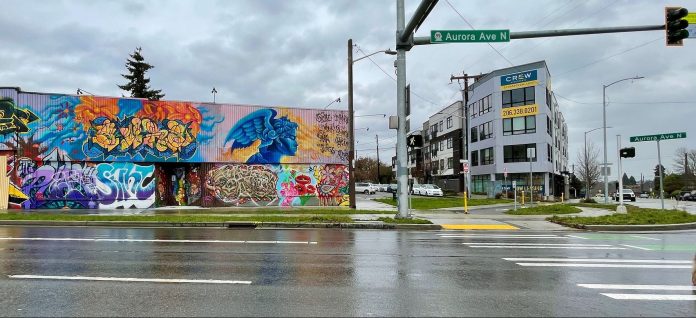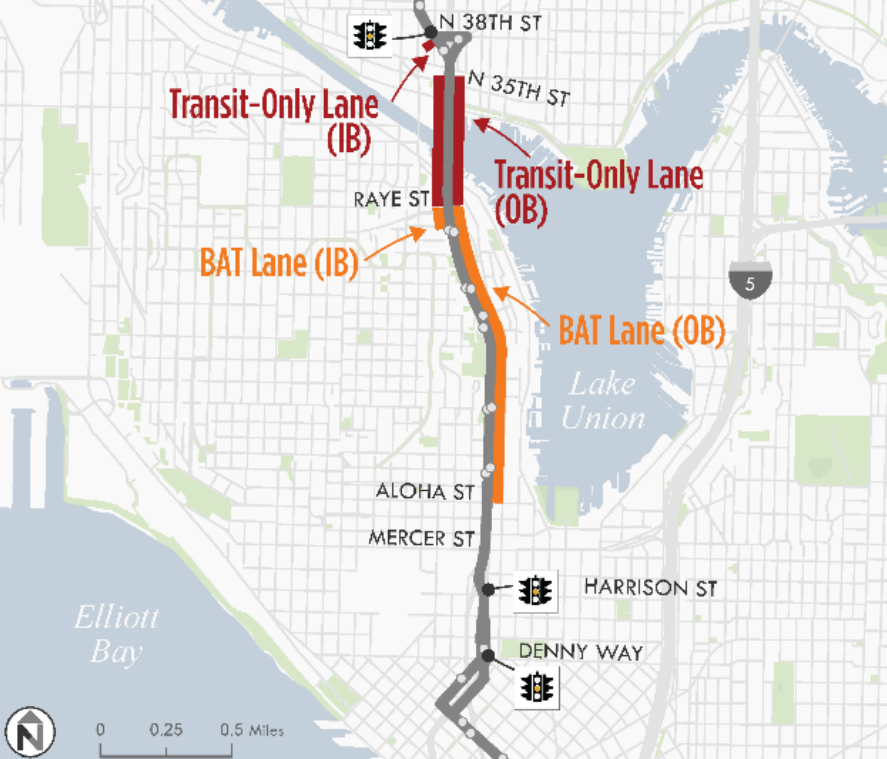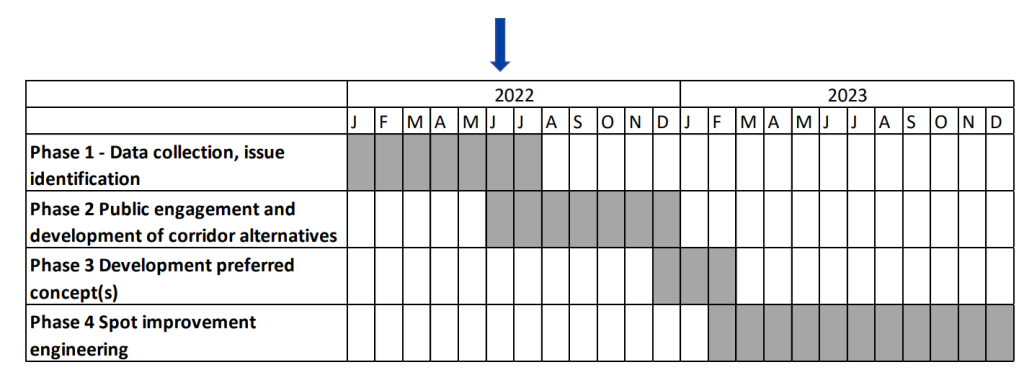
The Seattle Department of Transportation (SDOT) is beginning the outreach phase of its Aurora Avenue N planning study, a pivotal step toward vitally needed improvements that will help to fix one of the most deadly roads in the entire city. Originally planned as a bicycle and pedestrian safety study, SDOT has also announced that they will be teaming up with King County Metro to plan transit improvements on Aurora Avenue at the same time.
When the Washington State legislature allocated $50 million to fund construction of safety improvements on Aurora, it also passed legislative language setting a strict timeline for SDOT’s completion of the corridor study. The department has until September 30, 2023 to “fully complete” plans, and those plans must “prioritize designs that ensure slow vehicle speeds and systematic improvement to the quality of multimodal access,” per the state’s supplemental transportation budget passed this year.
The grant SDOT is using to fund design work requires that the department get to 90% design on improvements along at least two segments of the corridor. SDOT’s Brian Dougherty, a strategic advisor working on the project, told Seattle’s pedestrian advisory board last week that the current estimate for the full cost of improvements along Aurora is $200 million. However, the $50 million allocated by the legislature also has strings attached: legislative language prescribes that improvements should happen between N 90th Street and N 105th Street, which will “which will demonstrate the benefits of similar transportation investments for other locations along Aurora Avenue and elsewhere.”
Dougherty told the pedestrian advisory board that this requirement puts the department in “kind of a tough spot,” since they have not determined where the funding would do the most good along the seven mile corridor, between Seattle’s city limit at 145th Street and the north portal for the State Route (SR) 99 tunnel. The stretch between 90th and 105th is the segment where the state highway runs through the Aurora-Licton Springs urban village, and it has definitely been one of the most dangerous stretches for people walking in recent years. Additionally, most of the 30 blocks of Aurora Avenue that are missing sidewalks, another urgent priority for the street, are north of 105th.
Changes on Aurora Avenue have been needed for a long time. Between 2015 and 2019, Aurora was the location of a staggering 17% of the traffic fatalities that took place in the entire city. Half of those lives lost were people walking, who were only involved in only five percent of the total collisions along the street during that time period. Every additional month that passes without making safety improvements to the dangerous street increases the likelihood that another person is killed.

Adding transit improvements to the project will throw in an entire other level of complexity. According to SDOT, transit improvements to Aurora Avenue N will be focused around the E Line, the highest ridership bus in the entire system. But a 2022 Speed and Reliability Planning report obtained by The Urbanist identified Route 5, which runs on Aurora south of the Aurora bridge, as one of the biggest opportunities for improvement. Early concepts for Route 5 include transit-only lanes in both directions on the bridge.

Transit only lanes will likely prove to be a contentious element, but one that should be fully explored. The existing lane widths on the bridge are already narrow for a Metro coach, with many buses straddling the adjacent lane. Metro has not directly states what it believes the benefit of the bridge lanes alone would be, but the agency has expressed that an entire suite of improvements could speed up travel times on Route 5 by 10%, or by nearly 10 hours per day. Those travel time savings would also spill over onto other bus routes that use the Aurora bridge.
SDOT also announced that Seattle Public Utilities will attempt to piggyback on Aurora Avenue work to upgrade drainage along the corridor, with stormwater infrastructure having been unchanged on Aurora for decades. However, this utility work could add significant additional time to a construction schedule.
“We’re excited to see the close coordination and serious intent behind this project,” Tom Lang, with the Aurora Reimagined Coalition said in response to the latest news. “We plan to advocate for other city agencies to also focus on Aurora in the coming months and coordinate with SDOT, Metro, and SPU to make the most impact possible in the neighborhoods up and down the corridor.” The coalition has led the charge for systemic changes along the entire Aurora corridor, pushing successfully for the significant amount of state funding that has been awarded.
Another state requirement for funding is the creation of a “neighborhood oversight board” that will provide input through the design process. Nearly 20 years ago, Seattle was on the cusp of a complete revamp of Aurora Avenue that would have mirrored the improvements that Shoreline made to their portion of SR 99. Then, property owners like Faye Garneau (now passed away), the owner of the Aurora Collision Center, pushed back on the improvements. Issues like installing a center barrier, as currently exists on the Queen Anne portion of the street, became contentious on the north end. Bus lanes, which ended up being installed anyway in the years to come, were also a focal point of criticism. In the end, the money for improvements was actually returned.

All signs point to things playing out very differently now. Per the legislature, the entire $50 million must start to go out the door by March 1, 2024 and wrap up by 2029. In the immediate future, SDOT will develop a preferred concept for immediate spot improvements by early next year after this initial outreach phase is completed.
Ryan Packer has been writing for The Urbanist since 2015, and currently reports full-time as Contributing Editor. Their beats are transportation, land use, public space, traffic safety, and obscure community meetings. Packer has also reported for other regional outlets including BikePortland, Seattle Met, and PubliCola. They live in the Capitol Hill neighborhood of Seattle.

